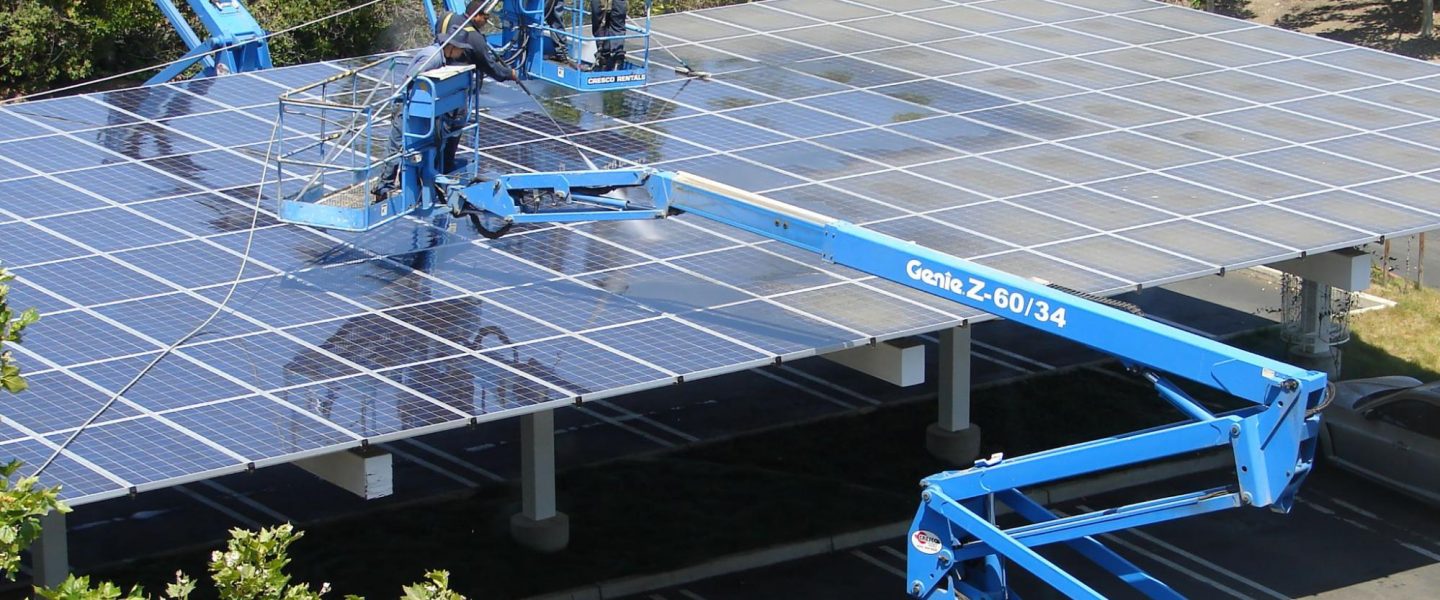Energy justice advocates are pointing out a gaping hole in making renewable energy more accessible: community solar.
This story by Sara Sax originally appeared in High Country News and is republished here as part of Covering Climate Now, a global journalism collaboration strengthening coverage of the climate story.
The community solar project in El Dorado Park, near Fresno, CA, had all the trappings of a great renewable energy project. It was designed with community input from the start. Almost all of El Dorado’s residents are low-income renters living in apartment buildings or multi-family housing units, and they wanted to have greenspace and community solar. They found two vacant lots in their neighborhood that the owners were willing to sell for a reasonable price, and, together with the El Dorado Community Development Corporation, they created a plan to build community gardens with solar canopies that would generate around 66 kilowatts of power — enough to power around two dozen homes. They would form a cooperative so they could manage the project themselves and receive dividends as owners for the energy they sold back to the utilities. In 2020, Shake Energy Collaborative, a women-owned renewable energy developer that partners with low-income communities, came aboard and applied to Pacific Gas and Electric under one of its programs for community solar, the Community Solar Green Tariff program.

“Everyone was super stoked about the project because it meant a garden, plus cheaper [energy] rates, plus community ownership over that solar, which would continue to be a valuable asset for the neighborhood,” Ali Andrews, the CEO of Shake Energy, told High Country News.
It was rejected. Twice — the second time for undisclosed reasons. But Andrews isn’t that surprised: Even as community solar has boomed in other states, it’s lagged far behind in the Golden State. In 2019, the Interstate Renewable Energy Council gave California C and D grades for the two primary ways it offers community solar, and it has received similar ratings elsewhere.
Energy justice advocates say that community solar is one of the most important ways to make renewable energy accessible to all, while community ownership is crucial to ensuring that solar’s benefits are more evenly distributed. Community solar — creating small solar farms on community centers, vacant lots, or nearby landfills — allows households who don’t own or have access to a roof for rooftop solar to still benefit from renewables. This is especially important for renters, who make up almost half of California’s residents and are more likely to be low-income and people of color.
“Rooftop solar only applies to single-family homeowners or those that have roofs that can actually get those rooftop solar installations,” said Alexis Sutterman, the energy equity program manager at the California Environmental Justice Alliance, a group of organizations that work with environmental justice communities in the state, told High Country News. “That leaves a lot of communities out, especially multi-tenant properties and multifamily affordable housing units.”
“[Rooftop solar] leaves a lot of communities out, especially multi-tenant properties and multifamily affordable housing units.”
It’s precisely those communities that would benefit most from having access to solar energy. On average, low-income and nonwhite households spend a much higher amount of their income on energy costs — up to 45 percent in some cases. Historically, they have also disproportionately suffered the health effects of living near oil and gas facilities. Yet almost 90 percent of California’s 1.3 million rooftop solar installations have been on single-family, owner-occupied homes; just over 10 percent of the households that benefit from reduced energy rates from solar are considered disadvantaged communities.

Now the California Public Utilities Commission is weighing a major decision to reform its net energy metering (NEM) policy for rooftop solar. This is the system that decides how much money residents will save from having solar. The state’s three major utilities say that the savings solar customers currently enjoy are so great that those customers no longer pay their fair share for the operation of the overall energy grid. A CPUC report explains that “the costs of NEM are disproportionately paid by younger, less wealthy, and more disadvantaged ratepayers, many of whom are renters.” The commission is using this as a way to justify its decision to change the benefits that solar customers receive. It also plans to charge those customers for using the grid, and to reduce the amount they are paid for the energy they sell back to utilities.

But if equity were truly a concern, energy justice advocates say, encouraging community ownership of solar would be the real focus. In February, the California Environmental Justice Alliance wrote a public letter to the utilities commission urging it, among other things, to “take immediate action towards expanding access to community solar projects in order to effectively reach renters and residents living in older housing who continue to face significant barriers and limited options to participating in the clean energy transition.” When asked to comment, CPUC replied that, though community solar is not being considered at the moment, according to the current Net Billing Tariff Proposed Decision, “CPUC … will consider community solar in the near future.”
California does have incentives for community solar, but few actual projects have been built. Programs like the Community Solar Green Tariff program that allow disadvantaged communities to benefit from utility-scale clean energy and receive a 20 percent discount on their energy bills inadvertently favor large, for-profit developers, said Ben Airth, the senior distributed generation policy manager at the Center for Sustainable Energy. That means that the actual long-term profits from community solar don’t go to the community. In addition, many of the related advantages — like job creation — end up benefiting large solar developers, rather than smaller and often more diverse businesses.
For community solar to effectively redistribute the benefits of renewables, both in the short and long term, it needs to be owned by the community, said Crystal Huang, co-founder and president of People Power Solar Cooperative. The biggest beneficiary of the energy transition is not the consumers who can go solar, she told High Country News, it’s the investors who are investing in the transition. “And if we’re talking about equity, you need to allow the consumer to become investors, especially low-income communities,” she said.

Huang’s organization and other groups, including the California Environmental Justice Alliance, tried to get community ownership of solar into the current NEM proposal last year as part of a larger testimony submitted to CPUC on behalf of the California Solar & Storage Association, a group representing over 600 businesses that work on solar energy production and services. But it was not included in CPUC’s proposed decision.
Without an intentional focus on and investments in community solar, Huang believes that many low-income communities and communities of color could be left out of the transition all together. California’s current debate over raising rates only skims the surface of a much larger equity issue that needs to be addressed, especially in a future where both energy infrastructure and access to energy will be challenged by climate change. “If we’re really talking about climate justice, if we’re really talking about shifting power,” Huang said, “then we are talking about a completely different grid that will address the reality we’re seeing today in 2022.”
Sarah Sax is an environmental journalist and producer, focusing on climate change, biodiversity, land rights and gender. Her work has appeared in outlets such as The Guardian, The Washington Post, Orion Magazine, WIRED, Mongabay, and Civil Eats. She was previously the climate justice reporting fellow at High Country News.




